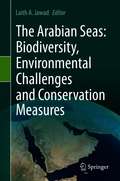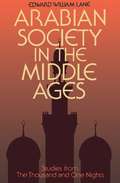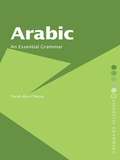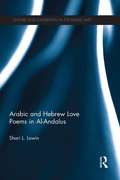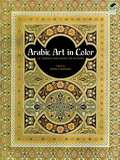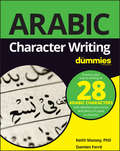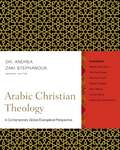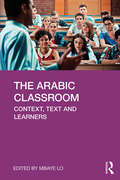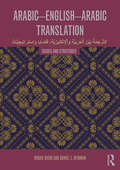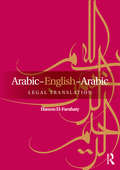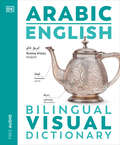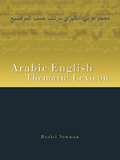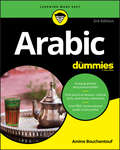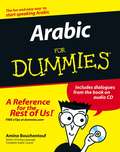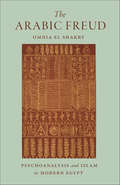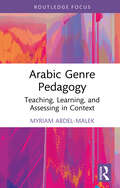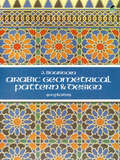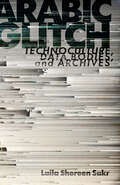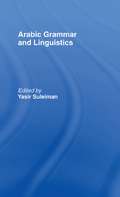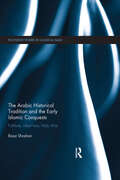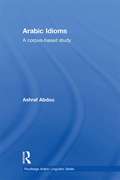- Table View
- List View
The Arabian Seas: Biodiversity, Environmental Challenges and Conservation Measures
by Laith A. JawadThe Arabian Seas Marine Region encompasses marine areas from Djibouti to Pakistan, including the northern part of Somalia, the Red Sea, the Arabian/Persian Gulf, and parts of the Arabian Sea. Human pressures on the coastal and marine environments are evident throughout the region, and have resulted in harmful environmental effects. Oil and domestic, urban and industrial pollutants in several areas of this part of the world have caused local habitat degradation, eutrophication and algal blooms. Further, coastal landfill, dredging, and sedimentation, as well as nutrient and sediment runoff from phosphate mining, agriculture and grazing, and reduction in freshwater seepage due to groundwater extraction are all contributing to the degradation of coastal environments. This book discusses aspects not covered in other books on the region, which largely focus on marine biodiversity, and examines several environmental challenges that are often ignored, but which have a significant impact on the environment. Evaluating the status quo, it also recommends conservation measures and examines the abiotic factors that play a major main role in the environmental changes. Lastly, the book addresses the biodiversity of the area, providing a general context for the conservation and management measures discussed.
Arabian Society Middle Ages: Studies From The Thousand And One Nights
by Clifford Edmund Bosworth Edward William Lane Stanley Lane-PooleFirst Published in 1995. Routledge is an imprint of Taylor & Francis, an informa company.
Arabians and Other Horses (World Book's Animals of the World)
by Karen IngebretsenIn a question and answer format the author introduces the Arabian horse and also discusses caring for a horse.
Arabic: An Essential Grammar
by Faruk Abu-ChacraArabic: An Essential Grammar is an up-to-date and practical reference guide to the most important aspects of the language. Suitable for beginners, as well as intermediate students, this book offers a strong foundation for learning the fundamental grammar and structure of Arabic. The complexities of the language are set out in short, readable sections, and exercises and examples are provided throughout. The book is ideal for independent learners as well as for classroom study. Features of this book include: coverage of the Arabic script and alphabet a chapter on Arabic handwriting a guide to pronunciation full examples throughout.
Arabic
by Karin C. RydingThis new edition, updated and with additional exercises, equips those who work, travel, and study in Arab countries with an educated form of spoken Arabic that functions flexibly in the face of various regional colloquial variants in the Arab world. Because the Arabic language has a number of very different spoken vernaculars, being able to speak and be understood in all Arab countries has become a challenge for English speakers. Ryding and Mehall have designed a course that teaches a standardized variant of spoken Arabic that is close to, but more natural than, the literary Modern Standard Arabic. With a non-grammar-based approach, this book fosters communicative competence in Arabic on all levels and develops speaking proficiency without abandoning Arabic script. It has proven to be clear, effective, and relevant to the needs of Americans living and working in the Arab East. Task-based lessons feature basic dialogues between Americans and Arabs, explanations of new structures, vocabulary expansion, and exercises; and provide gradual access to the sounds and script of Arabic by emphasizing listening and reading comprehension first, then slowly adding oral exercises and activities until the student has achieved basic proficiency. Not intended for self-instruction for beginners, Formal Spoken Arabic Basic Course with MP3 Files assumes some previous knowledge of Modern Standard Arabic, Arabic script and phonology, and previous or simultaneous instruction in orthography. This new edition includes a CD of MP3 audio exercises that are keyed to the text and drill students on listening and speaking. Lessons cover topics including:Heads of StateCities and CountriesOfficial TitlesGeographySystems of GovernmentLost LuggageGetting AcquaintedEstablishing Common GroundSeeking and Giving InformationPersonal Needs and FamilyHandling ProblemsEating OutBargaining and Buying
Arabic and Hebrew Love Poems in Al-Andalus (Culture and Civilization in the Middle East)
by Shari LowinArabic and Hebrew Love Poems in al-Andalus investigates a largely overlooked subset of Muslim and Jewish love poetry in medieval Spain: hetero- and homo-erotic love poems written by Muslim and Jewish religious scholars, in which the lover and his sensual experience of the beloved are compared to scriptural characters and storylines. This book examines the ways in which the scriptural referents fit in with, or differ from, the traditional Andalusian poetic conventions. The study then proceeds to compare the scriptural stories and characters as presented in the poems with their scriptural and exegetical sources. This new intertextual analysis reveals that the Jewish and Muslim scholar-poets utilized their sacred literature in their poems of desire as more than poetic ornamentation; in employing Qur’ānic heroes in their secular verses, the Muslim poets presented a justification of profane love and sanctification of erotic human passions. In the Hebrew lust poems, which utilize biblical heroes, we can detect subtle, subversive, and surprisingly placed interpretations of biblical accounts. Moving beyond the concern with literary history to challenge the traditional boundaries between secular and religious poetry, this book provides a new, multidisciplinary, approach to existing materials and will be of interest to students, scholars and researchers of Islamic and Jewish Studies as well as to those with an interest in Hebrew and Arabic poetry of Islamic Spain.
Arabic Art in Color
by Prisse D’avennesHere are 141 designs and motifs in authentic full color from classic 19th century work by noted French historian -- a visual vocabulary of Islamic decorative art.
Arabic As A Secret Song (CARAF Books: Caribbean and African Literature Translated from French)
by Skyler ArtesThe celebrated and highly versatile writer Leïla Sebbar was born in French colonial Algeria but has lived nearly her entire adult life in France, where she is recognized as a major voice on the penetrating effects of colonialism in contemporary society. The dramatic contrast between her past and present is the subject of the nine autobiographical essays collected in this volume. Written between 1978 and 2006, they trace a journey that began in Aflou, Algeria, where her father ran a schoolhouse, and continued to France, where Sebbar traveled, alone, as a graduate student before eventually realizing her powerful creative vision. The pieces collected in this book capture an array of experiences, sensations, and sentiments surrounding the French colonial presence in Algeria and offer an intimate and prismatic reflection on Sebbar’s bicultural upbringing as the child of an Algerian father and French mother. Sebbar paints an unflinching portrait of her original disconnection from her father’s Arabic language and culture, depicting her struggle to revive a cultural heritage that her family had deliberately obscured and to convey the vibrant yet muted Arabic of her father and of Algeria. Looking back from numerous vantage points throughout her life, she presents the complicated and divisive dynamics of being raised "between two shores"--the colonized and the colonizer. CARAF Books: Caribbean and African Literature Translated from French
Arabic Character Writing For Dummies
by Keith Massey Damien FerréLearn to write in Arabic In Arabic, there are different levels of language. The written language, which is studied in this book, is literary Arabic, sometimes also called classical Arabic or even modern or standard Arabic. It is the language of the Quran, classical poetry, literature and the media. The Arabic plume consists of 28 consonants and three long vowels. Each consonant is accompanied by a vowel which is placed above or below the consonant. Arabic speakers are in great demand in the United States, due to the country's political commitments to the Middle East, but only 25 percent of non-native speakers know the language in enough detail to function as translators, interpreters, analysts, or field agents. Arabic Character Writing For Dummies helps you write this language clearly and correctly. Learn to write the Arabic alphabet Find free instructional videos, flashcards, and printable writing pages online Build upon your mastery of the language Get ahead at work or in your personal life Arabic Character Writing For Dummies is designed for beginners, students, and lifelong learners wishing to write in Arabic.
Arabic Christian Theology: A Contemporary Global Evangelical Perspective
by ZondervanTheology is not done in a vacuum. Our theology is affected by the culture in which we live, and our theology can have unexpected effects on the lives of Christians who live thousands of miles away. This point emerges clearly as we listen to seven Arabic evangelical theologians address issues that are of critical importance to Christians living as minorities in the Muslim world. North American readers may find that many of their assumptions are challenged as they see how respected Christian thinkers from a very different context address issues of biblical interpretation, national and international politics, culture and gender.
The Arabic Classroom: Context, Text and Learners
by Mbaye LoThe Arabic Classroom is a multicontributor work for trainee and in-service teachers of Arabic as a foreign language. Collected here is recent scholarly work, and also critical writing from Arabic instructors, Arabists and language experts, to examine the status of the teaching and learning of Arabic in the modern classroom. The book stresses the inseparability of the parameters of contexts, texts and learners in the effective Arabic classroom and investigates their role in enhancing the experience of teaching and learning Arabic. The book also provides a regional perspective through global case studies and encourages Arabic experts to search for better models of instruction and best practices beyond the American experience.
Arabic-English-Arabic-English Translation: Issues and Strategies
by Ronak Husni Daniel L. NewmanArabic-English-Arabic-English Translation: Issues and Strategies is an accessible coursebook for students and practitioners of Arabic-English-Arabic translation. Focusing on the key issues and topics affecting the field, it offers informed guidance on the most effective methods to deal with such problems, enabling users to develop deeper insights and enhance their translation skills. Key features include: A focus on Arabic-English translation in both directions, preparing students for the real-life experiences of practitioners in the field In-depth discussion of the core issues of phraseology, language variation and translation, legal translation and translation technology in Arabic and English translation Authentic sample texts in each chapter, taken from a variety of sources from across the Arabic-speaking world to provide snapshots of real-life language use Source texts followed by examples of possible translation strategies, with extensive commentaries, to showcase the best translation practices and methodologies A range of supporting exercises to enable students to practise their newly acquired knowledge and skills Inclusion of a wide range of themes covering both linguistic and genre issues, offering multidimensional perspectives and depth and breadth in learning List of recommended readings and resources for each of the topics under discussion Comprehensive glossary and bibliography at the back of the book. Lucid and practical in its approach, Arabic-English-Arabic-English Translation: Issues and Strategies will be an indispensable resource for intermediate to advanced students of Arabic. It will also be of great interest to professional translators working in Arabic-English-Arabic translation.
Arabic-English-Arabic Legal Translation
by Hanem El-FarahatyArabic-English-Arabic Legal Translation provides a groundbreaking investigation of the issues found in legal translation between Arabic and English. Drawing on a contrastive-comparative approach, it analyses parallel authentic legal documents in both Arabic and English to examine the features of legal discourse in both languages and uncover the different translation techniques used. In so doing, it addresses the following questions: What are the features of English and Arabic legal texts? What are the similarities and differences of English and Arabic legal texts? What are the difficult areas of legal translation between English and Arabic legal texts? What are the techniques for translating these difficult areas on the lexical and syntactic levels? Features include: A thorough description of the features of legal translation in both English and Arabic, drawing on empirical new research, corpus data analysis and strategic two-way comparisons between source texts and target texts Coverage of a broad range of topics including an outline of the chosen framework for data analysis, a historical survey of legal discourse developments in both Arabic and English and detailed analyses of legal literature at both the lexical and syntactic levels Attention to common areas of difficulty such as Shariah Law terms, archaic terms and model auxiliaries Many examples and excerpts from a wide selection of authentic legal documents, reinforced by practical discussion points, exercises and practice drills to encourage active engagement with the material and opportunities for hands-on learning. Wide-ranging, scholarly and thought-provoking, this will be a valuable resource for advanced undergraduates and postgraduates on Arabic, Translation Studies and Comparative Linguistics courses. It will also be essential reading for translation professionals and researchers working in the field.
Arabic - English Bilingual Visual Dictionary (DK Bilingual Visual Dictionaries)
by DKWith more than 6,750 fully illustrated words and phrases in Arabic and English, along with a free bilingual audio app, DK's Arabic-English Bilingual Visual Dictionary is your essential companion to learning Arabic.You will find all the words and phrases you need to buy food and clothes, talk about work and education, visit the doctor, go to the bank, use public transportation, and much more. Perfect for students, tourists, and business travelers, the dictionary is incredibly easy to follow, with thematically organized vocabulary so you can find closely related words on a particular topic. Words and phrases are illustrated with full-color photographs and artwork, helping to fix new vocabulary in your mind. The supporting audio app enables you to hear all the words and phrases spoken out loud in both languages to help you learn, remember, and pronounce important vocabulary.
Arabic-English Thematic Lexicon
by Daniel L. NewmanThe Arabic-English Thematic Lexicon is an invaluable resource for all learners of Arabic. It contains some 8,000 entries, arranged into themes, including flora and fauna, food and drink, the human body, health care, the family, housing, clothing, education, IT, sports, politics, economics and commerce, the law, media, language, geography, travel, religion, arts, science, and natural resources. Three appendices cover the names of Arab and selected non-Arab regions, countries and capitals, and international organizations. The entries in the Lexicon have been drawn from an extensive corpus of contemporary Standard Arabic vocabulary, based on authentic sources. In addition to verbs, nouns and adjectives, the Lexicon includes phrases and commonly used collocations, providing users with the necessary vocabulary in order to communicate effectively and confidently in both written and spoken standard Arabic. The Lexicon provides an indispensable complement to Arabic grammar instruction and also serves as a useful reference guide for all Arabic language users.
Arabic For Dummies
by Amine BouchentoufStart reading and speaking Arabic Arabic For Dummies helps readers start speaking Modern Standard Arabic in no time. Whether you’re a student, traveler, or work in business or government, you’ll find this title to be packed with practical lessons, cultural facts, and handy references. Inside, you’ll find guidance on basic grammar, as well as the necessary vocabulary to make introductions and greetings, use proper etiquette, make small talk, make transportation arrangements, order food and beverages, ask directions, deal with money, shop, access recreation, and handle an emergency. Features new and revised content Offers a revamped, user-friendly design to both pedagogy and organization Includes expanded coverage of grammar, verb conjugations, and pronunciations Get free access to conversational audio tracks online If you want to start speaking Arabic, this go-to book is packed with practical instruction, cultural facts, and handy references you won’t want to be without!
Arabic For Dummies
by Amine BouchentoufRegarded as one of the most difficult languages to learn for native English speakers by the U. S. State Department, Arabic is gaining both prominence and importance in America. Recent world events have brought more and more Americans and other English speakers into contact with Arabic-speaking populations, and governments and businesses are increasingly aware of the importance of basic Arabic language skills. Arabic for Dummies provides you with a painless and fun way to start communicating in Arabic. Why should you learn Arabic? Well, besides the fact that over 200 million people in more than 22 nations use it to communicate, there are tons of reasons to get up to speed this 1,400 year old language, including: Nearly all of the Middle-East speaks Arabic or one of its dialects Basic Arabic skills are extremely useful for anyone traveling to, doing business in, or serving in the Middle East It is the language in which the Koran is written There is a rich, centuries-old literary tradition in Arabic Arabic For Dummies presents the language in the classic, laid-back For Dummies style. Taking a relaxed approach to this difficult language, it's packed with practice dialogues and communication tips that will have you talking the talk in no time. You'll get the scoop on: The Arabic alphabet, pronunciation, basic grammar, and the rules of transliteration The history of the language and information on classical Arabic and its dialects How to make small talk and make yourself understood when dining, shopping, or traveling around town How to communicate on the phone and in business conversations Handy words and phrases for dealing with money, directions, hotels, transportation, and emergencies Arabic culture and etiquette, including ten things you should never do in Arabic countries The book also includes an Arabic-English dictionary, verb tables, and an audio CD with dialogues from the book to help you perfect your pronunciation. Written by a native Arabic speaker who helped start a year-round Arabic department at Middlebury College, Arabic For Dummies is just what you need to start making yourself understood in Arabic. Note: CD-ROM/DVD and other supplementary materials are not included as part of eBook file.
The Arabic Freud: Psychoanalysis and Islam in Modern Egypt
by Omnia El ShakryThe first in-depth look at how postwar thinkers in Egypt mapped the intersections between Islamic discourses and psychoanalytic thoughtIn 1945, psychologist Yusuf Murad introduced an Arabic term borrowed from the medieval Sufi philosopher and mystic Ibn ‘Arabi—al-la-shu‘ur—as a translation for Sigmund Freud’s concept of the unconscious. By the late 1950s, Freud’s Interpretation of Dreams had been translated into Arabic for an eager Egyptian public. In The Arabic Freud, Omnia El Shakry challenges the notion of a strict divide between psychoanalysis and Islam by tracing how postwar thinkers in Egypt blended psychoanalytic theories with concepts from classical Islamic thought in a creative encounter of ethical engagement.Drawing on scholarly writings as well as popular literature on self-healing, El Shakry provides the first in-depth examination of psychoanalysis in Egypt and reveals how a new science of psychology—or “science of the soul,” as it came to be called—was inextricably linked to Islam and mysticism. She explores how Freudian ideas of the unconscious were crucial to the formation of modern discourses of subjectivity in areas as diverse as psychology, Islamic philosophy, and the law. Founding figures of Egyptian psychoanalysis, she shows, debated the temporality of the psyche, mystical states, the sexual drive, and the Oedipus complex, while offering startling insights into the nature of psychic life, ethics, and eros.This provocative and insightful book invites us to rethink the relationship between psychoanalysis and religion in the modern era. Mapping the points of intersection between Islamic discourses and psychoanalytic thought, it illustrates how the Arabic Freud, like psychoanalysis itself, was elaborated across the space of human difference.
Arabic Genre Pedagogy: Teaching, Learning, and Assessing in Context (Topics in Arabic Applied Linguistics)
by Myriam Abdel-MalekArabic Genre Pedagogy: Teaching, Learning, and Assessing in Context views Modern Standard Arabic and all spoken varieties of Arabic as one system and offers genre-based instructional resources grounded in systemic functional linguistics (SFL) and genre theory. Divided into three parts, this book explores the Theoretical and Instructional Framework, Spoken Genres, and Written Genres with chapters focusing on everyday social genres including exchanging information, chit-chat, and complaints. This book is aligned with the ACTFL framework and the instructional goals for each genre are articulated in terms of the ACTFL Can-Do Statements. Designed to support instructors of Arabic novice-intermediate learners, the chapters offer step-by-step lessons with practical classroom activities on how to make the language related to each genre explicit to students. Arabic Genre Pedagogy serves as a valuable guide and professional development resource for instructors of Arabic as a world language and for researchers of SFL-informed genre-based approach.
Arabic Geometrical Pattern and Design (Dover Pictorial Archive)
by J. BourgoinNearly 200 examples exhibit the wide range of Islamic art, including hexagon and octagon designs, combinations of stars and rosettes, and many variations on other geometric patterns. Twenty-eight examples from traditional sources in Cairo and Damascus include sanctuary doors, openwork windows, and inlaid marble pavements and ceilings.
Arabic Glitch: Technoculture, Data Bodies, and Archives
by Laila Shereen SakrArabic Glitch explores an alternative origin story of twenty-first century technological innovation in digital politics—one centered on the Middle East and the 2011 Arab uprisings. Developed from an archive of social media data collected over the decades following the 2003 U.S. invasion of Iraq, this book interrogates how the logic of programming technology influences and shapes social movements. Engaging revolutionary politics, Arab media, and digital practice in form, method, and content, Laila Shereen Sakr formulates a media theory that advances the concept of the glitch as a disruptive media affordance. She employs data analytics to analyze tweets, posts, and blogs to describe the political culture of social media, and performs the results under the guise of the Arabic-speaking cyborg VJ Um Amel. Playing with multiple voices that span across the virtual and the real, Sakr argues that there is no longer a divide between the virtual and embodied: both bodies and data are physically, socially, and energetically actual. Are we cyborgs or citizens—or both? This book teaches us how a region under transformation became a vanguard for new thinking about digital systems: the records they keep, the lives they impact, and how to create change from within.
Arabic Grammar and Linguistics
by Yasir SuleimanThis book explores aspects of the Arabic Grammatical Tradition and Arabic Linguistics from both a theoretical and descriptive perspective. It also touches on issues of relevance to other disciplines, particularly Qur'anic exegesis and jurisprudence. The links between the fields of language and religion are historically strong in the Arabic and Islamic traditions as so much time and effort was spent by grammarians in interpreting the precise meanings of two of the main sources of Islamic jurisprudence - the Quran and Hadith. Prof Suleiman has assembled an international team of experts in this area and presents a thorough review of the sources and arguments. The book will be of interest to all students, researchers and teachers of Arabic Language and Culture.
Arabic Grammar in Context (Languages in Context)
by Mohammad AlhawaryArabic Grammar in Context offers a unique and exciting approach to learning grammar. It presents grammar as a necessary and essential tool for understanding Arabic and for developing comprehension and production skills. Features include: authentic texts from a rich variety of sources, literary and non-literary, used as the starting point for the illustration and explanation of key areas of Arabic grammar clear and authoritative demonstration of the relevance of grammar for understanding and interpreting Arabic a wide range of appropriate exercises designed to consolidate learning fully vocalized exercises and texts a glossary of vocabulary and expressions provided at the end of the book audio readings of the texts available online for additional listening practice. Suitable for class use and independent study, Arabic Grammar in Context is ideal for intermediate to advanced learners of Arabic.
The Arabic Historical Tradition & the Early Islamic Conquests: Folklore, Tribal Lore, Holy War
by Boaz ShoshanThe early Arab conquests pose a considerable challenge to modern-day historians. The earliest historical written tradition emerges only after the second half of the eighth century- over one hundred years removed from the events it contends to describe, and was undoubtedly influenced by the motives and interpretations of its authors. Indeed, when speaking or writing about the past, fact was not the only, nor even the prime, concern of Muslims of old. The Arabic Historic Tradition and the Early Islamic Conquests presents a thorough examination of Arabic narratives on the early Islamic conquests. It uncovers the influence of contemporary ideology, examining recurring fictive motifs and evaluating the reasons behind their use. Folklore and tribal traditions are evident throughout the narratives, which aimed to promote individual, tribal and regional fame through describing military prowess in the battles for the spread of Islam. Common tropes are encountered across the materials, which all serve a central theme; the moral superiority of the Muslims, which destined them to victory in God’s plan. Offering a key to the state of mind and agenda of early Muslim writers, this critical reading of Arabic texts would be of great interest to students and scholars of early Arabic History and Literature, as well as a general resource for Middle Eastern History.
Arabic Idioms: A Corpus Based Study (Routledge Arabic Linguistics Series)
by Ashraf AbdouIdioms represent a fascinating linguistic phenomenon that has captured the attention of many linguists for decades. This corpus-based study of idioms in Modern Standard Arabic sheds light on their intricate nature, establishes the major patterns of their linguistic behaviour, and provides explanations for these patterns. Adopting a descriptive framework, the study addresses two main issues with regard to the discursive behaviour of idioms: the discursive functions that they perform and the ways in which they contribute to the cohesion of their texts. Examining primary data with regard to the semantic, discursive, lexical and grammatical properties of Arabic idioms, the author touches on the ubiquity of these expressions in language use, the wide range of functions they perform in discourse, the problems they often cause in domains such as foreign language learning and translation, and their typical divergence from the normal rules of grammar and semantic compositionality. Providing explanations for major linguistic phenomena, this analysis will be accessible to linguists, translators, lexicographers, translation software developers, and language teachers as well as learners.
